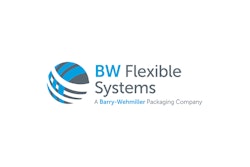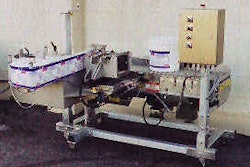Responding to consumer requests for added convenience, Fishers, IN-based Golden Stream Quality Foods began shipping in March many of its popular candy and snack mixes for the first time in a bag with an easy-open tear strip and zipper that provides reclosability. According to company president & CEO Stephen Farber, Golden Stream spent two years researching product- and package-related considerations before launching the reclosable bags. Some 120 Kroger supermarkets within Indiana were first to receive the clear plastic bags. Nationwide sales are expected to follow "as soon as it's reasonable." Initially, 12 SKUs were offered in the new zipper bag, although retailer requests for other products are already upping that figure. Golden Stream expects the reclosables to complement its twist-tie bags and bulk bin offerings sold within the same section of the supermarket. And while the retail bag will likely account for most of its volume, Golden Stream is also offering foodservice distributors about 15 SKUs in a metallized bag structure containing 2 lb of product. The package provides restaurants with the convenience of a reclosable bag. Somewhat surprisingly, the new bags hardly tout the reclosable convenience. Why not? "We wanted the bag to carry minimal graphics," Farber explains. "We added the reclosable feature to satisfy consumers who were asking for it, but we also wanted them to be able to see as much of our product within the bag as possible. That see-through characteristic appeals to consumers seeking 'natural' products within the produce section of the supermarket." Product identification, ingredient and weight statements and a UPC code are printed onto a pressure-sensitive label that's hand-applied to the "back" panel of the bag, on top of part of the finseal. Applied in-line The tear strip and zipper are applied to rollstock via AMI RecPro's (Atlanta, GA) Model 22290-25 system. Golden Stream is the first installation of the compact applicator. The new machine measures 70" H x 56" W x 58" W, as compared to the supplier's 122" x 61" x 94" "tower" system. The smaller footprint permits zipper application in much tighter quarters. Several factors caused Golden Stream to opt for in-line zipper application rather than purchase rollstock with a preapplied zipper. "We're able to buy the tear strip and zipper material for less than a penny per foot," explains Farber, "which is considerably less than what we would have paid for the preapplied zipper stock." Farber and technical director Mike Sutula concur that in-line application also provides greater control when heat sealing the zipper and tear strip to the base film material. This helps the packager more accurately track film scrap. In-line application also reduces turnaround time and increases flexibility for Golden Stream. As Sutula explains, "We can provide our customers with different colors of zippers on a just-in-time basis, whereas with preapplied stock we have to buy one film and one zipper in lot quantities. Before we made our final decision on this matter, we made economic comparisons and determined that if we had any kind of reasonable sales volume with zippered bags, we'd get a better payback on in-line zipper application equipment than buying preapplied zipper rollstock." Once the decision to apply zippers in-line was made, Golden Stream had to wrestle with the "chicken and egg" dilemma of whether to first purchase equipment or film. "Our methodology was to install a machine that would meet our needs and then develop a film structure. Many of the film requirements are based on the machinery," says Farber. "We looked at various machines, but felt AMI RecPro was ahead of other manufacturers'. We bought its machine and had it running in October of '94. We did some test runs with the zippered package and sold some zippered bags commercially, though on a very limited basis. We didn't promote the zipper at all on that package. After this test run, we backed off for a while to make determinations on the film structure, graphics for the package and to determine what products to sell in the zippered bags." Good film barriers The base film for the retail package, converted by Hargro Packaging (Exton, PA), comprises 84-ga acrylic-coated oriented polypropylene, reverse-printed flexographically in three colors and adhesive-laminated to 2-mil linear low-density polyethylene. Its water vapor transmission ratio is .19 g/100" sq/24 hr, while its oxygen transmission rate is 0.1 cc maximum/100" sq/24 hr. "The bag structure provides excellent water and oxygen barriers and it also has a shiny surface that gives it a look and feel of quality," says Farber. For the foodservice bag, Atlanta Film Converting (Atlanta, GA) laminates 48-ga metallized polyester to 2.5-mils of PE. The lamination's WVTR is .045 g/100" sq/24 hr; oxygen is .01 cc/100" sq/24 hr. "This structure provides good quality for foodservice environments and does not require clarity like a retail package does," notes Farber. Golden Stream uses a 19" web width for both film structures so they can share the same forming collar during the f/f/s process. However, the different structures require machine adjustments to run efficiently. "There's different heat parameters and pressure sensitivity settings required for the rollstocks," says Sutula. "The metallized laminate requires more heat, for example, in the zipper former than the other material. You need more tension and pressure in the sealing jaws because of the physical melting properties of the film structures." As far as sealing the zipper, Sutula says, "the male and female parts fit and create a seal, but at the two ends the Hayssen machine crimps the ends to prevent leakage. After all, we do a nitrogen flush and there'd be no sense in doing that if we had leakage." The nitrogen is inserted through a tube into the forming collar as product is delivered into the bag, flushing out oxygen. Married to a vf/f/s Like the tower model, the new zipper applicator can work with either horizontal or vertical form/fill/seal machinery. At Golden Stream, the AMI Rec/Pro is married to a vf/f/s machine made by Hayssen (Sheboygan, WI), in what the packager refers to as its "A" line. The line accommodates either zippered or nonzippered rollstock. The zipper is applied via a patent-pending process the company considers proprietary. The process begins as one DC motor drives the base film from its unwind at the front end of the machine, while another drives the LDPE zipper material, also from AMI Rec/Pro, from a spool at the side of the machine. A polyester tear strip, again from AMI Rec/Pro, unwinds from the top of the machine and is sealed to the base web. Sensors are used to synchronize the two materials as they're heat-sealed, nearly simultaneously, to the base web/tear strip. The process is continuous. The zippered structure is then driven through a series of dancer rollers that help maintain proper web tension between the continuous-motion of the AMI Rec/Pro unit and the intermittent-motion of the vf/f/s machine downstream. Flexible filling AMI Rec/Pro says that its unit can keep up with fill rates of up to 75 bags/min, though Golden Stream packages in the 35 to 40 bpm range. Continuous-motion belts index the zippered film over the forming collar on the Hayssen vf/f/s machine. The bottom and back fin then get heat-sealed prior to filling. Product is manufactured in various departments within Golden Stream's 120ꯠ-sq-ft facility, then brought to the A line. Golden Stream uses three Hayssen vf/f/s machines, but only the "A" line handles both the zippered and nonzippered bags. The line currently runs one shift seven days/wk, though Farber anticipates running two daily shifts, beginning in September, to meet holiday demands. Operators gently dump bins of product into a stainless-steel vibratory feed hopper at the beginning of the line. Product is conveyed from the bottom of the hopper in pivoting buckets, upwards approximately 15 feet, then horizontally where the pivoting buckets dump product that feeds into 14 scale buckets. A combination of scales release the appropriate amount of product from individual buckets to maximize fill accuracy. Product descends through the fill tube and into the waiting bag. After nitrogen flushing and heat-sealing the top of the bag, the bag is cut from the web and discharged. It rides an incline conveyor to a small circular table. At this point, operators apply the p-s label onto the bag, then hand-pack bags into corrugated boxes that get taped and manually palletized. While Golden Stream launched the reclosable retail bags in a 1-lb size, Farber says that "we may provide as much as a 2 pounds in a bag." Conversely, it's unlikely that any smaller quantities will use the zipper bag. "The 1-pound size creates a good image from a marketing standpoint," he says. "If we launch too many sizes, we may confuse buyers who like selling more standardized sizes." It's important to note that while the filled and sealed 1-lb bag width will always be approximately 8 1/2", its length may vary between 8" and 10". Sutula explains, "Bag lengths differ depending on density of the product. A pound of pretzels is rather fluffy, so that bag will be longer than a pound of chocolate raisins." To accommodate length variances, Golden Stream made the appropriate printing provisions. "When we worked on bag graphics, we designed them so that we could create a bag cutoff of any length," Sutula notes. That way, consumers can always read the "Easy Open," "Stay-Fresh Close & Reclose" statements on the zippered edge of the bag. The products selected for retail are among Golden Stream's more popular items. They include: chocolate-coated pretzels, vanilla yogurt and strawberry yogurt pretzels, chocolate-dipped peanuts, raisins and malted milk balls, as well as cashews, dried fruits, banana chips, apricots and salty snack mixes. Most of the foodservice SKUs are nuts and sunflower seeds, used primarily by restaurants to replenish salad bars. "The foodservice bag gives restaurants an advantage in portion control," says Farber. "They can add product to a salad bar, reclose the bag and put it away until they need it again. That's a lot more convenient than using a 10- or 20-pound bulk box or a number-10 steel can which costs more to ship." This bag measures 8 1/2" wide with a constant 13" cutoff length. It's too early for Golden Stream to determine its return on investment for the zipper applicator, but it already looks like a wise move. Within days after its first shipment, Farber reports, "we had a buyer request zipper bags for our jelly beans," a product that was not among the original SKUs targeted for the reclosable bag. "The key to this package is that the zipper provides convenience to the consumer," says Farber. "It helps convince retail and foodservice buyers that we have a better package. This helps get the product onto supermarket shelves. Consumers then see the product and they note that it has a user-friendly reclosable zipper. The zipper denotes that they're buying a longer-lasting, better quality product." And it gives Golden Stream yet another reason to market itself as a "first-choice" snack producer.



























